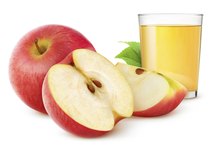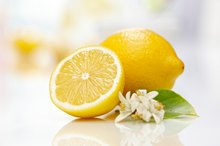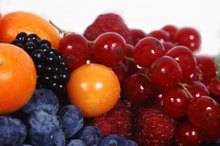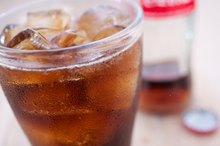What does fact checked mean?
At Healthfully, we strive to deliver objective content that is accurate and up-to-date. Our team periodically reviews articles in order to ensure content quality. The sources cited below consist of evidence from peer-reviewed journals, prominent medical organizations, academic associations, and government data.
- NIH: Quantitative Assessment of Citric Acid in Lemon Juice, Lime Juice, and Commercially-Available Fruit Juice Products
- NIH: Quantitative Assessment of Citric Acid in Lemon Juice, Lime Juice, and Commercially-Available Fruit Juice Products
The information contained on this site is for informational purposes only, and should not be used as a substitute for the advice of a professional health care provider. Please check with the appropriate physician regarding health questions and concerns. Although we strive to deliver accurate and up-to-date information, no guarantee to that effect is made.
Acid in Lemon Juice
Lemon juice has been valued for culinary, cosmetic and medicinal uses for thousands of years 1. Added to food, this citrus juice imparts a sharp, sour taste, while helping preserve the ingredients by preventing the process of oxidation that causes food to spoil 1. Lemon juice owes many of its characteristics to the acids it contains 1.
Identification
Lemon juice is a tangy, acidic liquid extracted from the fruit of the lemon tree, Citrus limon 1. The lemon is a small, light-yellow fruit with a pungent rind (peel) that contains pale yellow segmented pulp that holds the fruit’s juice 1. A medium lemon yields between 2 and 3 tbsp. of lemon juice, according to Food.com 1.
History
Acids Found in Apple Juice
Learn More
The lemon is native to the southern regions of Asia, from where it spread to the Mediterranean region, the Middle East and Northern Africa, according to the George Mateljan Foundation 2. It was first cultivated in America when Columbus arrived in the New World with lemon seeds in 1493 and planted them in Haiti. Today, it is widely distributed in numerous warm, sub-tropical regions of the world.
Acids
An acid is a compound with a sour taste that turns blue litmus paper red, writes the Physical and Theoretical Chemistry Laboratory at Oxford University, England 3. Depending on the temperature, acid can be in liquid, solid or gaseous form. An acid’s strength is measured in terms of its pH, or power of hydrogen, which is a numerical value denoting its hydrogen ion concentration. The more acidic a compound is, the lower its pH.
- An acid is a compound with a sour taste that turns blue litmus paper red, writes the Physical and Theoretical Chemistry Laboratory at Oxford University, England 3.
- An acid’s strength is measured in terms of its pH, or power of hydrogen, which is a numerical value denoting its hydrogen ion concentration.
Types
Importance of Acids and Bases
Learn More
Lemon juice is a very acidic fruit juice with an average pH of 2.3, writes Robert Clemens in his book “Organic Acids in Citrus Fruits.” He notes that citric acid is the predominant organic acid in it, with smaller but significant amounts of ascorbic acid (vitamin C) 1. The juice also contains malic acid. According to a study by the National Institutes of Health, lemon is a rich source of citric acid, containing 1.44 g per ounce. The USDA National Nutrient Database reports that each cup of lemon juice contains 112.2 mg of ascorbic acid and 0.251 mg of pantothenic acid 1.
Warning
Drugs.com cautions that citrus juice is often associated with aggravating the symptoms of GERD, or gastroesophageal reflux disease, a chronic digestive disorder that results when stomach acid flows backward (refluxes) into the food pipe 1. It also might erode or discolor tooth enamel.
Related Articles
References
- Food: Lemon Juice
- George Mateljan Foundation: Lemons/Limes
- The Physical and Theoretical Chemistry Laboratory: Safety Glossary Definition - Acid
- NIH: Quantitative Assessment of Citric Acid in Lemon Juice, Lime Juice, and Commercially-Available Fruit Juice Products
- Elshafie HS, Camele I. An overview of the biological effects of some mediterranean essential oils on human health. Biomed Res Int. 2017;2017:9268468. doi:10.1155/2017/9268468
- Goncalves NE, de Almeida HL Jr, Hallal EC, Amando M. Experimental phytophotodermatitis. Phytodermatology, Photoimmunology, and Photomedicine. 2005 Dec;21(6):318-21 doi:10.1111/j.1600-0781.2005.00186.x
- Zou Z, Xi W, Hu Y, Nie C, Zhou Z. Antioxidant activity of citrus fruits. Food Chemistry. 2016 Apr 1;196:885-96. doo:10.1016/j.foodchem.2015.09.072
- Kim DB, Shin GH, Kim JM, Kim YH, Lee JH, et. al. Antioxidant and anti-ageing activities of citrus-based juice mixture. Food Chemistry. 2016 Mar;194:920-7. doi:10.1016/j.foodchem.2015.08.094
Resources
Writer Bio
Based in Blue Springs (MO), the ArmChairGeek has worked as a freelancer since 2007. An alumni of the University of California, San Marcos, he specializes in writing health-related eBooks, articles and other web content for a number of websites, including Demand Studios, eHow and WiseGeek.









